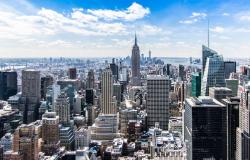
New York City, where the Manhattan Project began, has some of the world's oldest nuclear weapons production sites, exposing New Yorkers to ongoing risks of ionising radiation. This article considers six sites of particular environmental concern. Assessment, monitoring and clean-up of these locations have taken place over three different periods: private remediation before 1992; federal government remediation in the early 1990s followed by two decades of neglect; and a long-standing campaign to deal with risks at two remaining sites. Addressing radioactive legacies has involved a feedback loop between literal excavation of contaminated locations and a more hermeneutical process of meaning-making. Journalists, activists and politicians have transformed some places into sites of memory, cultivating connections to concerns about environmental justice, radiation protection and nuclear disarmament. The 2017 Treaty on the Prohibition of Nuclear Weapons (TPNW) established new obligations to remediate environments contaminated by nuclear weapons activities. While the USA refuses to join the TPNW, in-depth, historical study of remediation at these sites can provide useful insight for states parties establishing policy to implement TPNW obligations. Recent passage of nuclear disarmament legislation by the NY City Council shows the ongoing policy relevance of nuclear weapons issues in local policymaking.
Policy implications
- Remediation of contaminated environments is not just a technical process, but involves a kind of archaeology, both literally – excavating sites – and metaphorically, recovering community memory.
- Given extensive secrecy surrounding nuclear weapons activities, remediation also requires excavation of archives, making public what has hitherto been kept secret, private and obscured by technocratic discourse.
- More public and transparent processes of remediation render the history of environmental remediation visible and legible, leaving a trail that can be followed by others in the future, enabling the transformation of a contaminated site into a site of memory and policy conversation.
- As States Parties to the 2017 Treaty on the Prohibition of Nuclear Weapons make policy decisions regarding its environmental remediation obligation, they should ensure a transparent process, open to civil society and mindful of the importance of local memory.
Photo by Lukas Kloeppel